Multi-Buoy Deployment Method Based on an Improved Tuna Swarm Optimizer Enhanced with Fractional-Order Calculus Method for Marine Observation
Abstract
:1. Introduction
- (1)
- An observation model for buoys considering marine environmental factors is proposed, which can be optimized by any heuristic algorithm.
- (2)
- The observation coverage ratio and communication energy consumption of the multi-buoy system are derived in detail, and an optimized deployment model is established.
- (3)
- A novel improved tuna swarm optimizer enhanced with fractional-order calculus method (ITSFO) is proposed. The superiority of ITSFO is verified by simulation.
2. Preliminary
2.1. Tent Chaotic Mapping
2.2. Tuna Swarm Optimization
2.2.1. Spiral Foraging
2.2.2. Parabolic Foraging
2.3. Fractional-Order Calculus
3. Optimized Deployment Model of the Multi-Buoy System
3.1. Observation Model of Ocean Buoy
3.2. Observation Coverage Ratio of Multi-Buoy System
3.3. Communication Energy Consumption of Multi-Buoy System
3.4. The Optimized Deployment Model
4. The Proposed ITSFO Method
4.1. An Enhanced Tuna Swarm Optimization
4.2. Improved Tuna Swarm Optimizer Enhanced with Fractional-Order Calculus Method
4.2.1. Improved Spiral Foraging
4.2.2. Improved Parabolic Foraging
4.3. Flowchart and Pseudo-Code
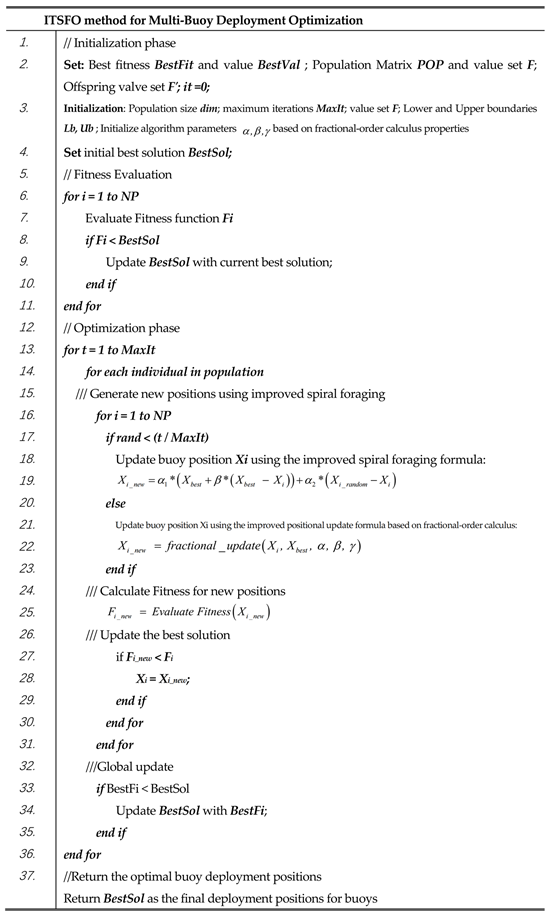 |
4.4. Wilcoxon Sign Rank Test
5. Simulation and Analysis
5.1. Coverage and Energy Consumption with Varying Weight Factor
5.2. Simulation Experiments for Single-Buoy
5.3. Simulation Experiments for Multi-Buoy System
6. Conclusions
Author Contributions
Funding
Data Availability Statement
Conflicts of Interest
References
- Song, B.; Pan, G.; Zhang, L.; Huang, Q.; Yu, Y.; Tian, W.; Dong, H.; Zhang, H. Development trend and key technologies of autonomous underwater vehicles. Chin. J. Ship Res. 2022, 17, 27–44. [Google Scholar]
- Zhang, W.; Wang, N.X.; Wei, S.; Du, X.; Yan, Z. Overview of unmanned underwater vehicle swarm development status and key technologies. J. Harbin Eng. Univ. 2020, 41, 289–297. [Google Scholar]
- Burguera, A.; Bonin-Font, F. Localization, Mapping and SLAM in Marine and Underwater Environments; MDPI-Multidisciplinary Digital Publishing Institute: Basel, Switzerland, 2022. [Google Scholar]
- Ren, R.; Zhang, L.; Liu, L.; Pan, G.; Huang, Q.; Chen, Y. Cooperative Deployment Planning of Underwater Unmanned Clusters Based on Hybrid Heuristic Algorithms. In Proceedings of the 2023 8th International Conference on Automation, Control and Robotics Engineering (CACRE), Hong Kong, China, 13–15 July 2023; pp. 300–306. [Google Scholar]
- Cheng, Z.; Fan, X.; Guo, L.; Cui, Y. A UUV target detection method based on informer. In Proceedings of the 2022 4th International Conference on Frontiers Technology of Information and Computer (ICFTIC), Qingdao, China, 2–4 December 2022; pp. 774–778. [Google Scholar]
- Andriyanov, N.; Soloviev, V.; Solomatin, D. Application of deep learning for augmentation and generation of an underwater dataset with industrial facilities. Bulletin of the South Ural State University. Ser. Comput. Technol. Autom. Control Radioelectron. 2023, 23, 5–16. [Google Scholar]
- Ren, R.; Zhang, L.; Liu, L.; Yuan, Y. Two AUVs guidance method for self-reconfiguration mission based on monocular vision. IEEE Sens. J. 2021, 21, 10082–10090. [Google Scholar] [CrossRef]
- Wang, H.; Li, Y.; Zhang, L.; Fan, Y.; Li, Z. A self-deployment algorithm for maintaining maximum coverage and connectivity in underwater acoustic sensor networks based on an ant colony optimization. Appl. Sci. 2019, 9, 1479. [Google Scholar] [CrossRef]
- Yang, Y.; Xiao, Y.; Li, T. A survey of autonomous underwater vehicle formation: Performance, formation control, and communication capability. IEEE Commun. Surv. Tutor. 2021, 23, 815–841. [Google Scholar] [CrossRef]
- Allard, Y.; Shahbazian, E.; Isenor, A. Unmanned Underwater Vehicle (UUV) Information Study; Defence Research and Development Canada: Ottawa, ON, Canada, 2014. [Google Scholar]
- Li, J.; Wang, L. Research on searching submarine evaluation of effectiveness of UUV. Ship Sci. Technol. 2016, 38, 206–208. [Google Scholar]
- Wu, Y.; Low, K.H.; Lv, C. Cooperative path planning for heterogeneous unmanned vehicles in a search-and-track mission aiming at an underwater target. IEEE Trans. Veh. Technol. 2020, 69, 6782–6787. [Google Scholar] [CrossRef]
- Detweiler, C.; Doniec, M.; Vasilescu, I. Autonomous Depth Adjustment for Underwater Sensor Networks: Design and Applications. IEEE ASME Trans. Mechatron. 2012, 17, 16–24. [Google Scholar] [CrossRef]
- Shahanaghi, A.; Yang, Y.L.; Buehrer, R.M. Stochastic Link Modeling of Static Wireless Sensor Networks over the Ocean Surface. IEEE Trans. Wirel. Commun. 2020, 19, 4154–4169. [Google Scholar] [CrossRef]
- Binitha, S.; Sathya, S.S. A survey of bio inspired optimization algorithms. Int. J. Soft Comput. Eng. 2012, 2, 137–151. [Google Scholar]
- Dhiman, G.; Kaur, A. STOA: A bio-inspired based optimization algorithm for industrial engineering problems. Eng. Appl. Artif. Intell. 2019, 82, 148–174. [Google Scholar] [CrossRef]
- Kar, A.K. Bio inspired computing—A review of algorithms and scope of applications. Expert Syst. Appl. 2016, 59, 20–32. [Google Scholar] [CrossRef]
- Sajith, G.; Srinivas, R.; Golberg, A.; Magner, J. Bio-inspired and artificial intelligence enabled hydro-economic model for diversified agricultural management. Agric. Water Manag. 2022, 269, 107638. [Google Scholar] [CrossRef]
- Qazi, W.; Qazi, S.; Iqbal, N.; Raza, K. The scope and applications of nature-inspired computing in bioinformatics. In Nature-Inspired Intelligent Computing Techniques in Bioinformatics; Springer Nature Singapore: Singapore, 2022; pp. 3–18. [Google Scholar]
- Xie, L.; Han, T.; Zhou, H.; Zhang, Z.R.; Han, B.; Tang, A. Tuna swarm optimization: A novel swarm-based metaheuristic algorithm for global optimization. Comput. Intell. Neurosci. 2021, 2021, 9210050. [Google Scholar] [CrossRef]
- Yan, Z.; Yan, J.; Wu, Y.; Cai, S.; Wang, H. A novel reinforcement learning based tuna swarm optimization algorithm for autonomous underwater vehicle path planning. Math. Comput. Simul. 2023, 209, 55–86. [Google Scholar] [CrossRef]
- Tan, M.; Li, Y.; Ding, D.; Zhou, R.; Huang, C. An improved jade hybridizing with tuna swarm optimization for numerical optimization problems. Math. Probl. Eng. 2022, 2022, 7726548. [Google Scholar] [CrossRef]
- Wang, J.; Zhu, L.; Wu, B.; Ryspayev, A. Forestry canopy image segmentation based on improved tuna swarm optimization. Forests 2022, 13, 1746. [Google Scholar] [CrossRef]
- Fan, C.; Wang, W.; Tian, J. Flexible job shop scheduling with stochastic machine breakdowns by an improved tuna swarm optimization algorithm. J. Manuf. Syst. 2024, 74, 180–197. [Google Scholar] [CrossRef]
- Kulkarni, R.V.; Venayagamoorthy, G.K. Bio-inspired algorithms for autonomous deployment and localization of sensor nodes. IEEE Trans. Syst. Man Cybern. Part C (Appl. Rev.) 2010, 40, 663–675. [Google Scholar] [CrossRef]
- Attea BA, A.; Abbas, M.N.; Al-Ani, M.; Özdemir, S. Bio-inspired multi-objective algorithms for connected set K-covers problem in wireless sensor networks. Soft Comput. 2019, 23, 11699–11728. [Google Scholar] [CrossRef]
- Senel, F. Coverage-aware connectivity-constrained unattended sensor deployment in underwater acoustic sensor networks. Wirel. Commun. Mob. Comput. 2016, 16, 2052–2064. [Google Scholar] [CrossRef]
- Su, Y.; Guo, L.; Jin, Z.; Fu, X. A Voronoi-based optimized depth adjustment deployment scheme for underwater acoustic sensor networks. IEEE Sens. J. 2020, 20, 13849–13860. [Google Scholar]
- Mosekilde, E.; Aracil, J.; Allen, P.M. Instabilities and chaos in nonlinear dynamic systems. Syst. Dyn. Rev. 1988, 4, 14–55. [Google Scholar] [CrossRef]
- Li, Y.-M.; Deng, Y.; Jiang, M.; Wei, D. Fast Encryption Algorithm Based on Chaotic System and Cyclic Shift in Integer Wavelet Domain. Fractal Fract. 2024, 8, 75. [Google Scholar] [CrossRef]
- Li, Y.-M.; Jiang, M.; Wei, D.; Deng, Y. A Novel Image Encryption Algorithm Based on Compressive Sensing and a Two-Dimensional Linear Canonical Transform. Fractal Fract. 2024, 8, 92. [Google Scholar] [CrossRef]
- Karolyi, G.; Péntek, A.; Scheuring, I.; Tél, T.; Toroczkai, Z. Chaotic flow: The physics of species coexistence. Proc. Natl. Acad. Sci. 2000, 97, 13661–13665. [Google Scholar] [CrossRef]
- Kaneko, K. Overview of coupled map lattices. Chaos Interdiscip. J. Nonlinear Sci. 1992, 2, 279–282. [Google Scholar] [CrossRef]
- Gorenflo, R.; Mainardi, F. Fractional Calculus: Integral and Differential Equations of Fractional Order; Springer: Vienna, Austria, 1997. [Google Scholar]
- Atanackovic, T.M.; Pilipovic, S.; Stankovic, B.; Zorica, D. Fractional Calculus with Applications in Mechanics: Vibrations and Diffusion Processes; John Wiley & Sons: Hoboken, NJ, USA, 2014. [Google Scholar]
- Ren, Y.; Li, L.; Wang, W.; Wang, L.; Pang, W. Magnetically Suspended Control Sensitive Gyroscope Rotor High-Precision Deflection Decoupling Method using Quantum Neural Network and Fractional-Order Terminal Sliding Mode Control. Fractal Fract. 2024, 8, 120. [Google Scholar] [CrossRef]
- Tumari, M.Z.M.; Ahmad, M.A.; Rashid, M.I.M. A fractional order PID tuning tool for automatic voltage regulator using marine predators algorithm. Energy Rep. 2023, 9, 416–421. [Google Scholar] [CrossRef]
- Peng, Y.; He, S.; Sun, K. Chaos in the discrete memristor-based system with fractional-order difference. Results Phys. 2021, 24, 104106. [Google Scholar] [CrossRef]
- Yang, Q.; Chen, D.; Zhao, T.; Chen, Y. Fractional calculus in image processing: A review. Fract. Calc. Appl. Anal. 2016, 19, 1222–1249. [Google Scholar] [CrossRef]
- Houssein, E.H.; Sayed, A. Dynamic candidate solution boosted beluga whale optimization algorithm for biomedical classification. Mathematics 2023, 11, 707. [Google Scholar] [CrossRef]
- Shah, P.; Agashe, S. Review of fractional PID controller. Mechatronics 2016, 38, 29–41. [Google Scholar] [CrossRef]
- Nail, B.; Atoussi, M.A.; Saadi, S.; Tibermacine, I.E.; Napoli, C. Real-Time Synchronisation of Multiple Fractional-Order Chaotic Systems: An Application Study in Secure Communication. Fractal Fract. 2024, 8, 104. [Google Scholar] [CrossRef]
- Reina, D.G.; Tawfik, H.; Toral, S.L. Multi-subpopulation evolutionary algorithms for coverage deployment of UAV-networks. Ad Hoc Netw. 2018, 68, 16–32. [Google Scholar] [CrossRef]
- Zhuang, Y.; Pan, J.; Cai, L. Minimizing energy consumption with probabilistic distance models in wireless sensor networks. In Proceedings of the 2010 Proceedings IEEE INFOCOM, San Diego, CA, USA, 14–19 March 2010; pp. 1–9. [Google Scholar]

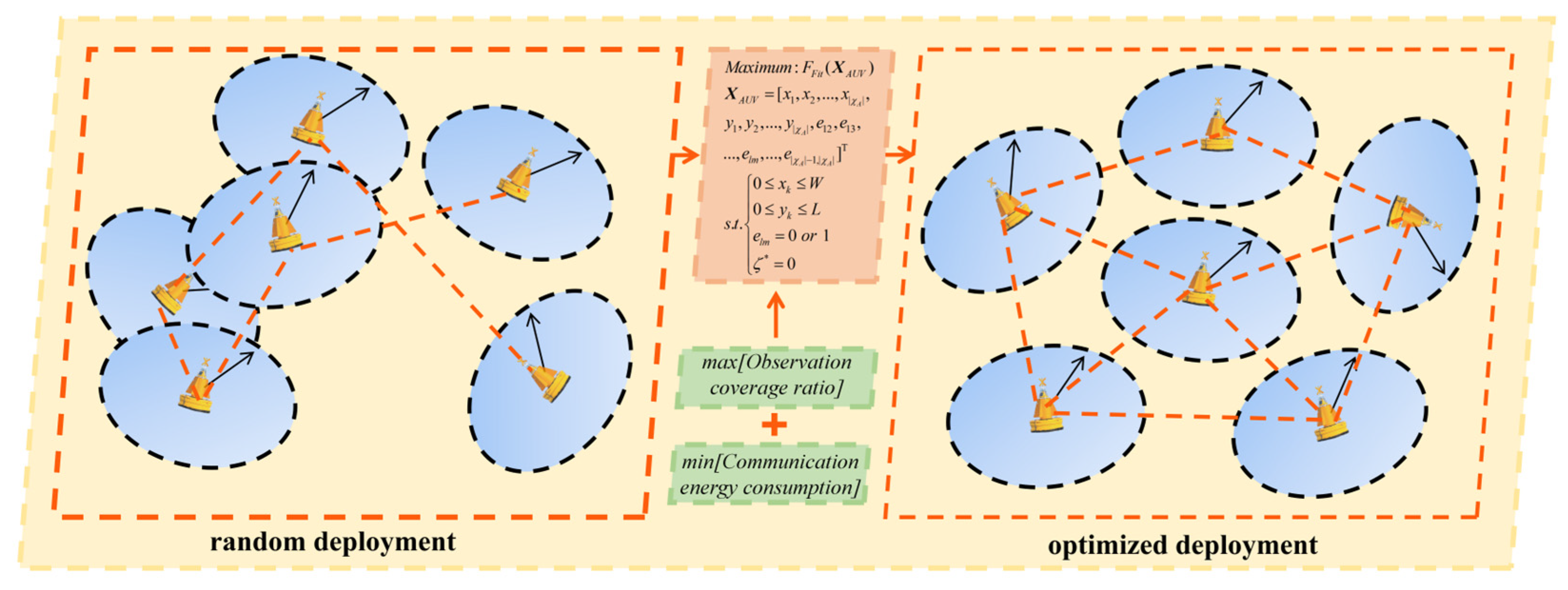

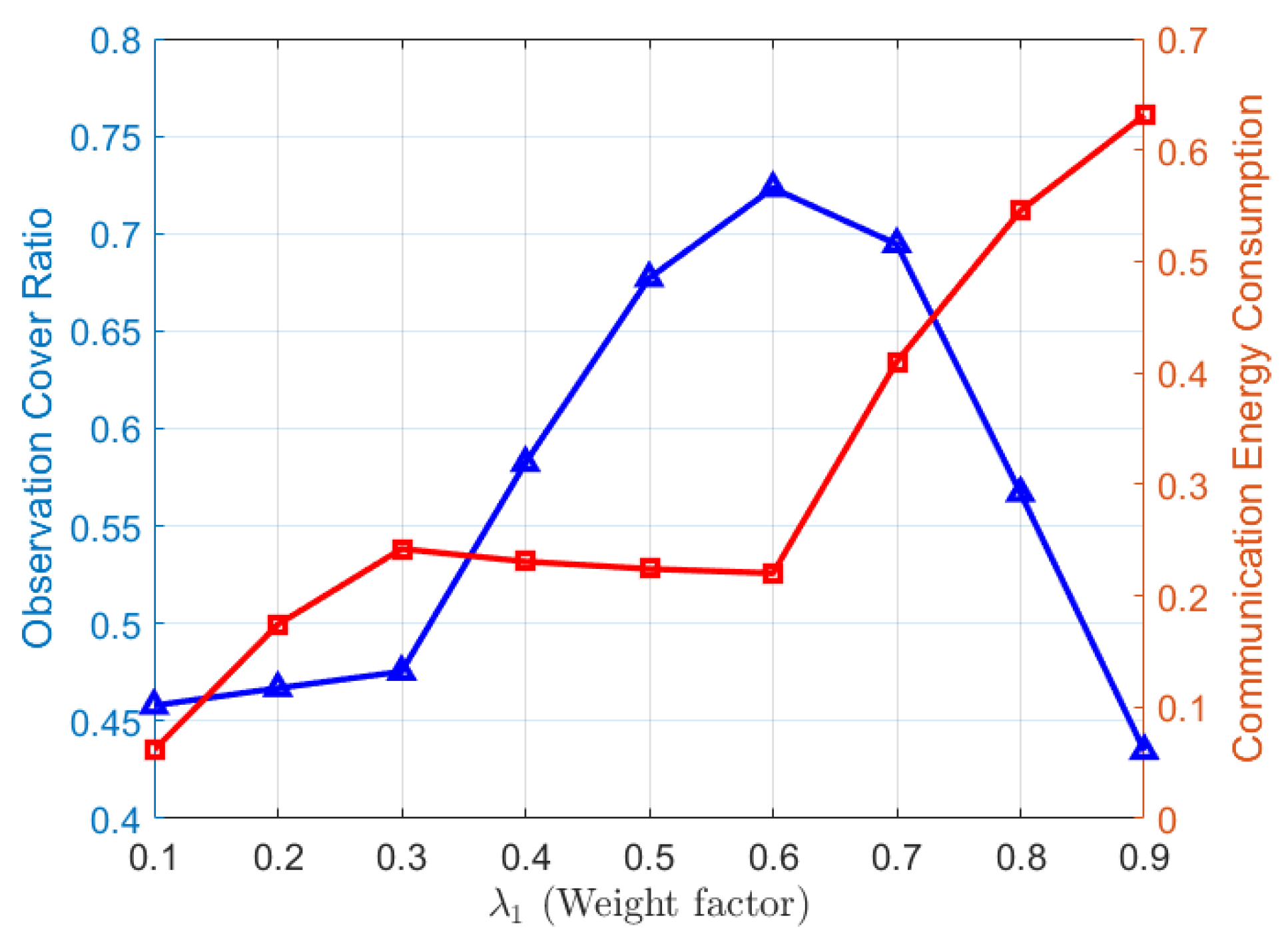

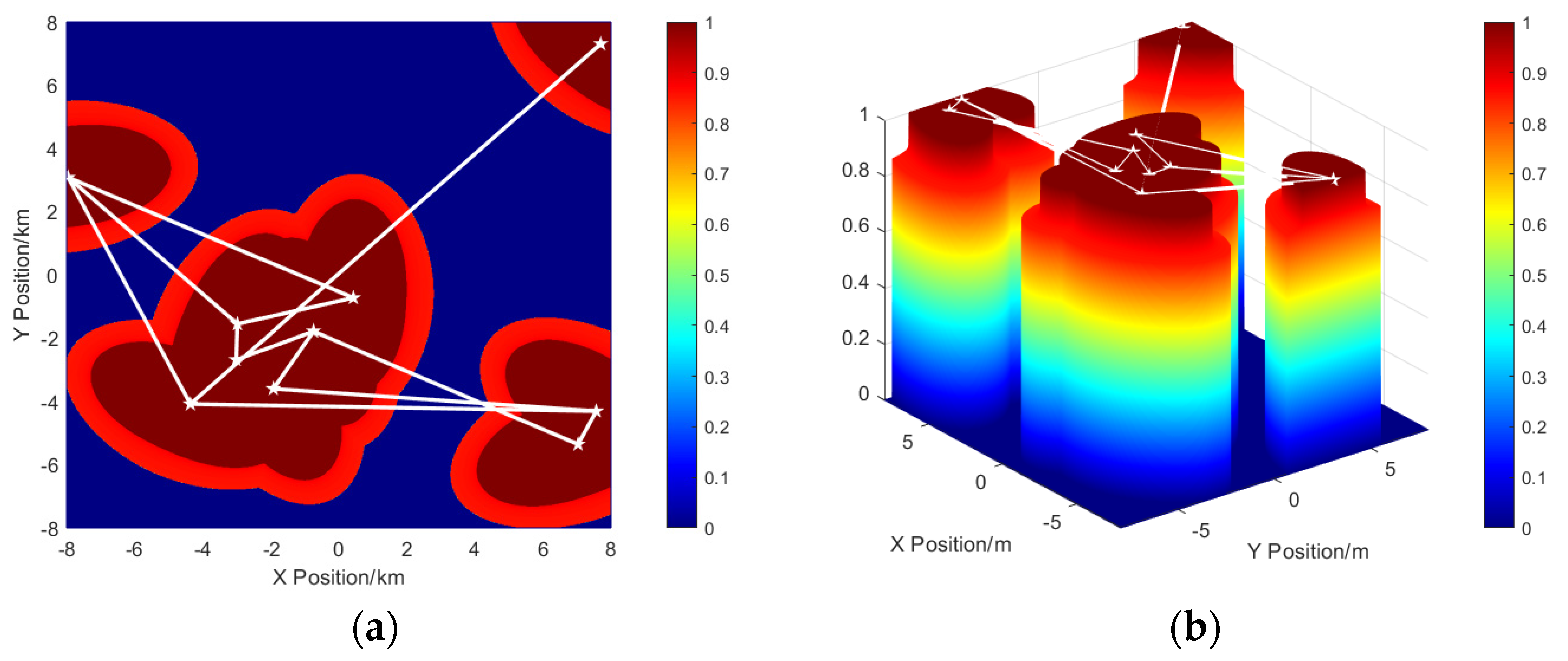



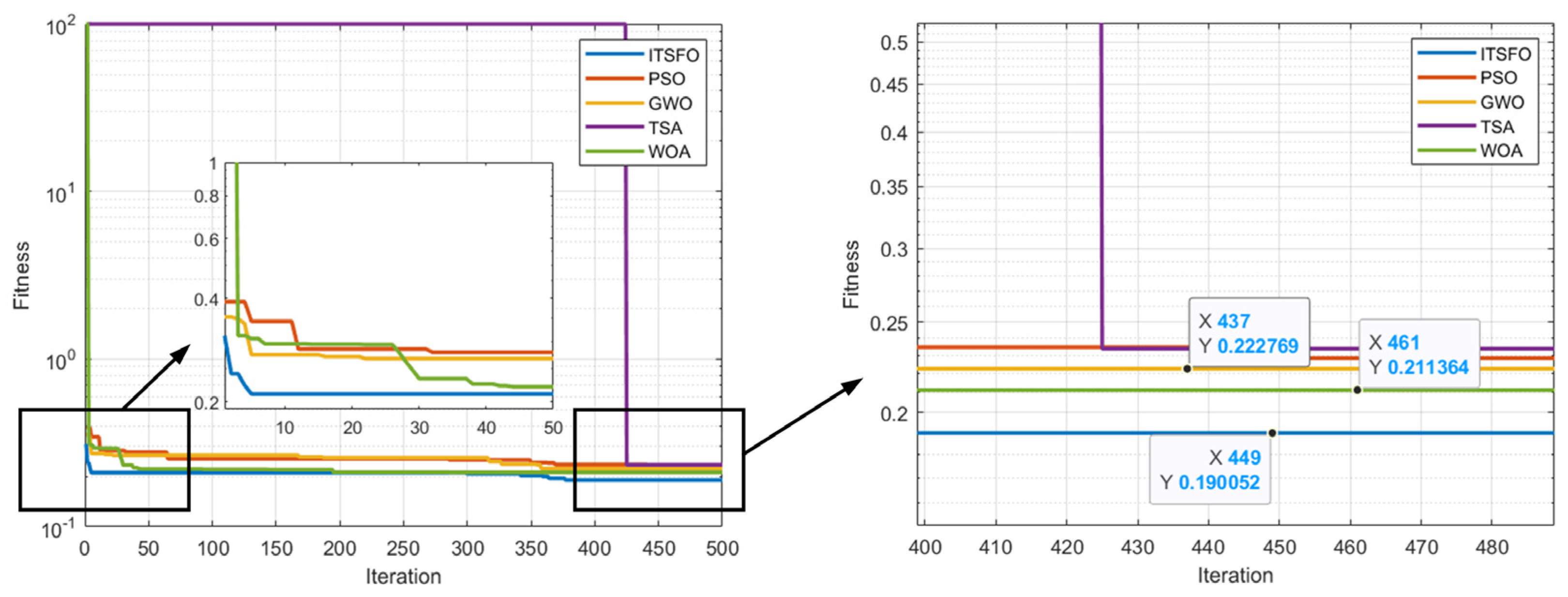

| Function | Description | ITSFO-TSO | |
|---|---|---|---|
| p | R | ||
| F1 | Unimodal benchmark functions | 3.5694 × 10−8 | + |
| F2 | Multimodal benchmark functions | 1.734398 × 10−6 | + |
| F3 | 7.56 × 10−10 | + | |
| F4 | 3.6788340 × 10−5 | + | |
| F5 | Fixed-dimension multimodal benchmark functions | 1.734398 × 10−6 | + |
| F6 | 4.254 × 10−9 | + | |
| F7 | 3.181679 × 10−6 | + | |
| F8 | 7.690859 × 10−6 | + | |
| Parameter | Value | Parameter | Value |
|---|---|---|---|
| W | 8 (km) | wind speed | 1.5 (m/s) |
| L | 8 (km) | noise frequency | 0.2 (kHz) |
| 3.5 (km) | target radiated noise | 185 (dB) | |
| 2.0 (km) | 0.3 (km) |
| ITSFO | PSO | GWO | TSA | WOA | TSO | |
|---|---|---|---|---|---|---|
| Mean (Fitness) | 0.189094 | 0.190442 | 0.196881 | 40.194884 | 0.199041 | 0.191472 |
| Best (Fitness) | 0.172417 | 0.184309 | 0.180676 | 0.184644 | 0.187526 | 0.180579 |
| Worst (Fitness) | 0.227168 | 0.257009 | 0.220404 | 200.220983 | 100.237393 | 0.246994 |
| Running time (s) | 641.416883 | 726.932109 | 674.909515 | 667.857276 | 694.136488 | 663.913382 |
Disclaimer/Publisher’s Note: The statements, opinions and data contained in all publications are solely those of the individual author(s) and contributor(s) and not of MDPI and/or the editor(s). MDPI and/or the editor(s) disclaim responsibility for any injury to people or property resulting from any ideas, methods, instructions or products referred to in the content. |
© 2024 by the authors. Licensee MDPI, Basel, Switzerland. This article is an open access article distributed under the terms and conditions of the Creative Commons Attribution (CC BY) license (https://creativecommons.org/licenses/by/4.0/).
Share and Cite
Ren, R.; Zhang, L.; Pan, G.; Zhang, X.; Liu, L.; Han, G. Multi-Buoy Deployment Method Based on an Improved Tuna Swarm Optimizer Enhanced with Fractional-Order Calculus Method for Marine Observation. Fractal Fract. 2024, 8, 625. https://doi.org/10.3390/fractalfract8110625
Ren R, Zhang L, Pan G, Zhang X, Liu L, Han G. Multi-Buoy Deployment Method Based on an Improved Tuna Swarm Optimizer Enhanced with Fractional-Order Calculus Method for Marine Observation. Fractal and Fractional. 2024; 8(11):625. https://doi.org/10.3390/fractalfract8110625
Chicago/Turabian StyleRen, Ranzhen, Lichuan Zhang, Guang Pan, Xiaomeng Zhang, Lu Liu, and Guangyao Han. 2024. "Multi-Buoy Deployment Method Based on an Improved Tuna Swarm Optimizer Enhanced with Fractional-Order Calculus Method for Marine Observation" Fractal and Fractional 8, no. 11: 625. https://doi.org/10.3390/fractalfract8110625
APA StyleRen, R., Zhang, L., Pan, G., Zhang, X., Liu, L., & Han, G. (2024). Multi-Buoy Deployment Method Based on an Improved Tuna Swarm Optimizer Enhanced with Fractional-Order Calculus Method for Marine Observation. Fractal and Fractional, 8(11), 625. https://doi.org/10.3390/fractalfract8110625







